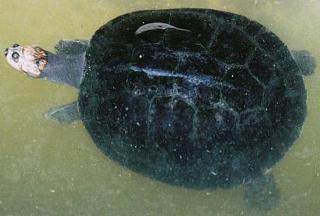


|
Pelomedusidae: Pelomedusids usually have oblong, moderately high-domed carapaces, large plastra (hinged in Pelusios, not hinged in Pelomedusa) and moderate-sized heads. The jaw closure mechanism articulates on a pterygoid trochlear surface that lacks a synovial capsule but contains a fluid-filled saclike duct from the buccal cavity. Both epipterygoid and parietal-squamosal contact is missing in the skull; the internal carotid canal lies in the prootic, and the postorbital has strong contact to the squamosal. The facial nerve has a hyomandibular branch. The plastron has a mesoplastron and well-developed plastral buttresses that articulate with the costals on each side of the carapace; the carapace has 11 pairs of sutured peripherals around its margin and a nuchal without costiform processes. The neck withdraws horizontally, and this mechanism is reflected in an anteriorly oriented articular surface of the first thoracic vertebra; other vertebral traits are the inclusion of the 10th thoracic vertebra in the sacral complex and procoelous caudal vertebrae. The pelvic girdle is firmly fused to the plastron, and the ilium lacks a thelial process. The karyotype is 2N = 34 or 36 (after Zug et al. 2001). |
